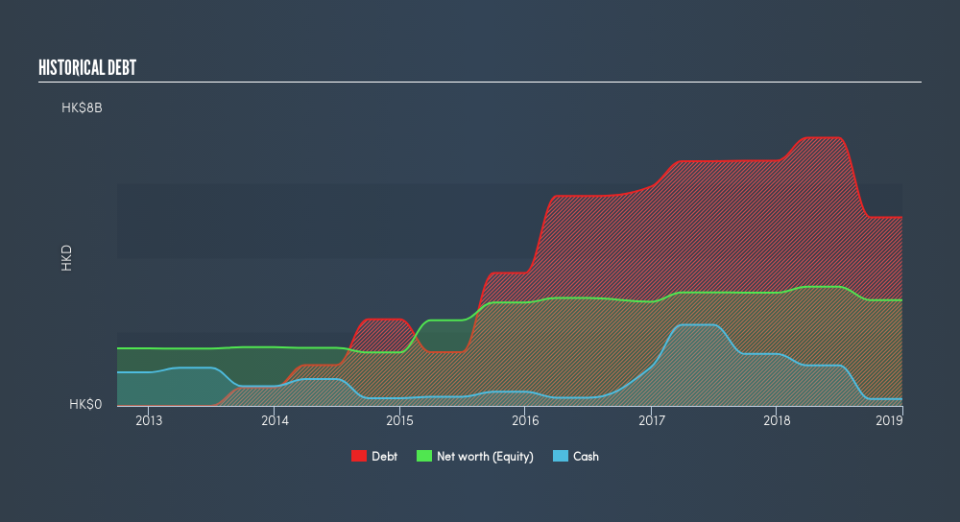Is DreamEast Group (HKG:593) Using Debt In A Risky Way?

Legendary fund manager Li Lu (who Charlie Munger backed) once said, 'The biggest investment risk is not the volatility of prices, but whether you will suffer a permanent loss of capital.' It's only natural to consider a company's balance sheet when you examine how risky it is, since debt is often involved when a business collapses. We can see that DreamEast Group Limited (HKG:593) does use debt in its business. But the real question is whether this debt is making the company risky.
When Is Debt A Problem?
Debt and other liabilities become risky for a business when it cannot easily fulfill those obligations, either with free cash flow or by raising capital at an attractive price. If things get really bad, the lenders can take control of the business. However, a more usual (but still expensive) situation is where a company must dilute shareholders at a cheap share price simply to get debt under control. By replacing dilution, though, debt can be an extremely good tool for businesses that need capital to invest in growth at high rates of return. The first thing to do when considering how much debt a business uses is to look at its cash and debt together.
View our latest analysis for DreamEast Group
What Is DreamEast Group's Debt?
As you can see below, DreamEast Group had HK$5.09b of debt at December 2018, down from HK$6.61b a year prior. However, it does have HK$185.5m in cash offsetting this, leading to net debt of about HK$4.90b.
A Look At DreamEast Group's Liabilities
Zooming in on the latest balance sheet data, we can see that DreamEast Group had liabilities of HK$3.35b due within 12 months and liabilities of HK$4.49b due beyond that. Offsetting this, it had HK$185.5m in cash and HK$925.1m in receivables that were due within 12 months. So its liabilities outweigh the sum of its cash and (near-term) receivables by HK$6.73b.
The deficiency here weighs heavily on the HK$2.18b company itself, as if a child were struggling under the weight of an enormous back-pack full of books, his sports gear, and a trumpet. So we'd watch its balance sheet closely, without a doubt After all, DreamEast Group would likely require a major re-capitalisation if it had to pay its creditors today. When analysing debt levels, the balance sheet is the obvious place to start. But it is DreamEast Group's earnings that will influence how the balance sheet holds up in the future. So if you're keen to discover more about its earnings, it might be worth checking out this graph of its long term earnings trend.
In the last year DreamEast Group actually shrunk its revenue by 87%, to HK$160m. That makes us nervous, to say the least.
Caveat Emptor
Not only did DreamEast Group's revenue slip over the last twelve months, but it also produced negative earnings before interest and tax (EBIT). To be specific the EBIT loss came in at HK$116m. Combining this information with the significant liabilities we already touched on makes us very hesitant about this stock, to say the least. That said, it is possible that the company will turn its fortunes around. But we think that is unlikely, given it is low on liquid assets, and burned through HK$966m in the last year. So we think this stock is risky, like walking through a dirty dog park with a mask on. For riskier companies like DreamEast Group I always like to keep an eye on the long term profit and revenue trends. Fortunately, you can click to see our interactive graph of its profit, revenue, and operating cashflow.
If you're interested in investing in businesses that can grow profits without the burden of debt, then check out this free list of growing businesses that have net cash on the balance sheet.
We aim to bring you long-term focused research analysis driven by fundamental data. Note that our analysis may not factor in the latest price-sensitive company announcements or qualitative material.
If you spot an error that warrants correction, please contact the editor at editorial-team@simplywallst.com. This article by Simply Wall St is general in nature. It does not constitute a recommendation to buy or sell any stock, and does not take account of your objectives, or your financial situation. Simply Wall St has no position in the stocks mentioned. Thank you for reading.

